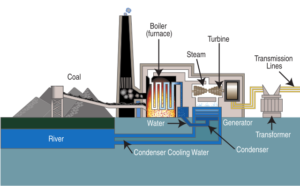Information below comes from the Environmental Defense Fund and was released June 26, 2018. (Image below from Tennessee Valley Authority).
With serious reservations expressed by three judges, the U.S. Court of Appeals for the District of Columbia Circuit has again issued a limited 60-day abeyance of litigation over the Clean Power Plan. The court also once again rejected EPA’s request for indefinite suspension of the litigation.
In separate concurrences, three judges raised specific and pointed concerns that Clean Power Plan opponents are abusing the current status of the litigation to avoid EPA’s duty to protect Americans from the threat of climate pollution.

The Clean Power Plan is the historic measure that establishes America’s only nationwide limits on carbon pollution from existing power plants.
“Today’s decision comes after the Trump Administration has delayed any meaningful action to reduce carbon pollution from the nation’s power plants for well over a year – and shows no sign that it intends to fulfill its legal obligation to do so,” said EDF Senior Attorney Martha Roberts. “Although it is disappointing that the court has yet to rule on the merits of the Clean Power Plan, EDF stands ready and resolved to ensure that EPA fulfills its legal obligation to protect the health and safety of all Americans from the dangers of climate change.”
Today’s order is the fifth time since April of 2017 that the court has issued a temporary stay – and the fifth time the court rejected the Trump Administration’s request for an indefinite suspension of the litigation. Today’s order will be in effect for 60 days, and the court will continue to require status reports from EPA every 30 days.
As part of today’s order, three judges raised serious concerns about EPA’s repeated requests for delay.
Judge Wilkins, joined by Judge Millet, said:
“I will join in one further abeyance, but I am writing to apprise the parties that it is the last one that I am inclined to grant.”
Judge Wilkins described EPA’s history of delay, saying:
“The upshot is that the Petitioners and EPA have hijacked the Court’s equitable power for their own purposes. If EPA or the Petitioners wish to delay further the operation of the Clean Power Plan while the agency engages in rulemaking, then they should avail themselves of whatever authority Congress gave them to do so, rather than availing themselves of the Court’s authority under the guise of preserving jurisdiction over moribund petitions.”
Judge Tatel, joined again by Judge Millet in a separate concurrence, highlighted:
“EPA’s own judicially upheld determination that greenhouse gases pose an ongoing threat to public health and welfare” and the Supreme Court’s “decades-old recognition in Massachusetts v. EPA that … EPA must take regulatory action in the fact of such a determination.”
He denounced “the untenable status quo” which:
“derives in large part from petitioners’ and EPA’s treatment of the Supreme Court’s order staying implementation of the Clean Power Plan … as indefinite license for EPA to delay compliance with its obligation under the Clean Air Act to regulate greenhouse gases.”
The Clean Power Plan, which was finalized in August 2015, will reduce carbon pollution from the power sector to 32 percent below 2005 levels. It will save up to 4,500 lives each year, prevent up to 90,000 childhood asthma attacks each year, and prevent more than 300,000 missed school and work days each year once fully implemented, according to EPA’s own estimates. The Clean Power Plan provides states and power companies broad flexibility to determine how best to meet these emission reduction goals, including through the deployment of energy efficiency measures that would save an average American family almost $85 on its annual energy bills.
Image above: Tennessee Valley Authority
Topic: Clean Power Plan information update.
